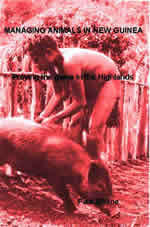Managing Animals in New Guinea | Paul Sillitoe
Managing Animals in New Guinea deals with the place of animals in the subsistence regime of New Guinea Highlanders.
It investigates the classification, exploitation and management of both wild and domesticated creatures. The Highlands region has extensive areas of rainforest, which are home to a wide range of game animals. And bristly wild-looking pigs are to be seen everywhere in settled parts of valleys, people keeping sizeable herds.
The book comprises the fourth in a series studying the subsistence regime of the Wola people of the Papua New Guinea Highlands, one of the most comprehensive studies in existence. The volume on crops, their classification, propagation and consumption is Roots of the Earth: the cultivation and classification of crops in the Papua New Guinea highlands (Manchester University Press, 1983). The one on natural resources, soils and the environment is A Place Against Time: land and environment in the Papua New Guinea highlands (Harwood Academic 1996). And the one on horticultural practices, swidden cultivation and crop husbandry is Horticulture in Papua New Guinea: case studies from the Southern and Western Highlands. (Ethnology Monographs No. 18, 2002 (with P. Stewart & A. Strathern).
The same approach to ethnographic, scientific and theoretical issues informs this study of animals as the previous volumes in the series. The aim throughout is to present the ethnography and related quantitative data as evidence which support possible answers to issues which their investigation initially pose, dubbed ‘ethnographic determinism’.
The assumption about the natural environment allows the book to adopt a long term perspective on animal exploitation in the Highlands. It uses contemporary practices to speculate on the course of events during prehistory, such as the feasibility of seasonal visitors to the region as opposed to forager populations living there. There are consequences too for understanding of biodiversity and conservation, two contemporary issues of interest. It turns to ecological theory to investigate the cost of living in the Highlands region. A time and energy accounting approach not only questions assumptions about hunting and gathering in the past and puts the relative notion of affluence in an intriguing comparative context, but it also shows that whileanimal rearing, notably of domestic pigs, may give a good return, if animals are slaughtered when adult, people regularly keep them for years and may incur negative energy returns on their labour. This relates to the high cultural premium put on pigs which relates to socio-political exchange.
Transactional considerations drive the ‘economy’ and consideration of these informs this study, like the previous ones. The assumption about the centrality of exchange activity is borne out of a conviction that it is pivotal to understanding the broadly speaking ‘economic’ issues addressed in this book. Many creatures are not only good to eat but they are also good to give away, serving as wealth that persons may present to one another in the socio-political exchanges that feature centrally in Highland society. ‘Playing the game’ and earning social respect demands whole-hearted commitment to transaction. People kill and eat creatures at infrequent communal events that bring celebrity to all, being large collective displays and transactions of animal wealth. We can see their acephalous political legacy in their attitudes to animals. One of the key issues to understanding observed events and behaviour, is to comprehend compliance with the continuance of a markedly egalitarian socio-political environment and the centrality of personal autonomy, and the implications for what goes on. The focus on the socio-political dimensions of animals in stateless transactional contexts is new. It is a different emphasis to that prominent in many anthropological studies of animals to-date.
Más información
Additional appendices are available on the following website: : http://www.dur.ac.uk/paul.sillitoe/animals/inde...
Comentarios
CIRAD © 2007 (Derechos reservados) - Legales informaciones - Actualizaión de la pagina : 02/04/2007
